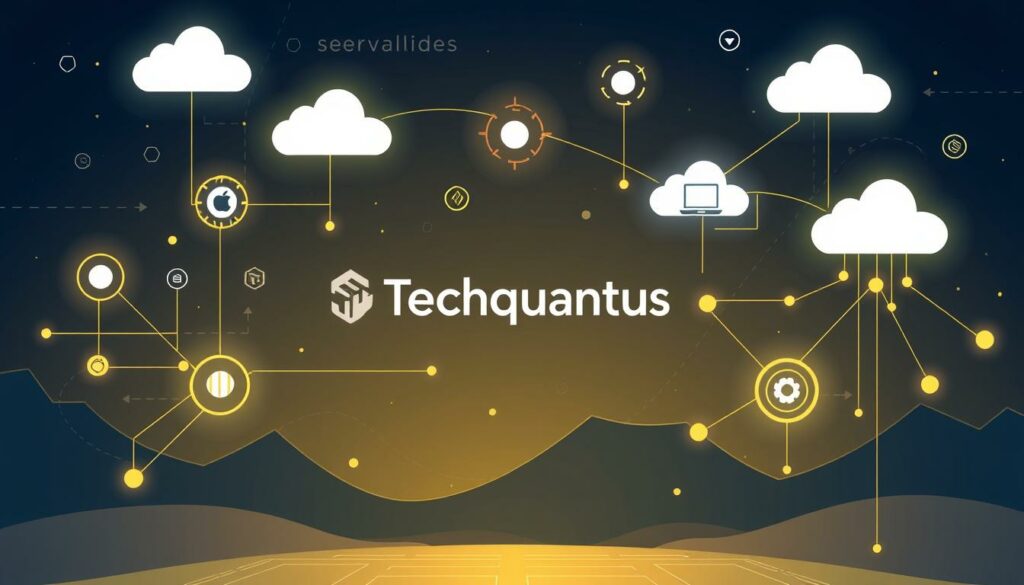Did you know that moving to serverless computing can save up to 70%? This shows the big financial benefits of switching from old server management to serverless. As we move into 2024, more businesses are choosing serverless computing for its efficiency, scalability, and cost savings.
This shift is part of a bigger trend in tech. It’s about using cloud computing and serverless together. In this article, we’ll cover the basics of serverless computing, its benefits, and how to make the switch. You’ll learn how cloud services like IaaS, PaaS, and SaaS help, and the cost savings you can get. For more on edge vs cloud computing, check this article.
Choosing serverless computing can change how your business works. It’s not just a trend; it’s a big change in how companies run today and tomorrow.
Key Takeaways
- Serverless computing can provide significant cost reductions.
- The flexibility of serverless architecture enhances business scalability.
- Understanding cloud computing fundamentals is crucial for a smooth transition.
- Key services like AWS Lambda can facilitate serverless computing adoption.
- Evaluating your current infrastructure allows for optimal planning.
- Implementing best practices will ensure effective serverless application management.
Introduction to Serverless Computing
Serverless computing changes how we make apps, letting you focus on coding, not servers. Cloud services take care of the servers, making apps deploy fast and grow easily. This approach makes making apps faster and more innovative, while simplifying the complex parts of traditional servers.
Serverless computing is different from old cloud models. With traditional methods, you manage servers yourself, dealing with computing and storage. But serverless automatically gives you the resources you need, so you only pay for what you use. This big change helps your company be quicker and more adaptable to new market trends.
Looking into serverless options can help solve problems in system design and efficiency. This new tech lets developers create apps that are stronger and adjust to what users want. For more details on how serverless computing works with Cyber–Physical–Social Systems, check out this in-depth article.
Understanding Cloud Computing Fundamentals
Cloud computing is a key innovation in today’s business world. It offers services that make businesses more flexible and save money. At its heart, it includes models like Infrastructure as a Service (IaaS). This lets companies manage their infrastructure online without owning the hardware. Big names like AWS and Azure are leading the way, offering strong platforms for different business needs.
Cloud Computing has three main service models:
- Infrastructure as a Service (IaaS): This model gives businesses virtual computing resources online, helping them grow efficiently.
- Platform as a Service (PaaS): This service lets developers build, deploy, and manage apps without dealing with the infrastructure.
- Software as a Service (SaaS): This model delivers software over the internet on a subscription basis, making it easy for companies to use apps without installing them.
Using Cloud Computing can greatly improve how businesses work. It lets companies quickly adapt to new demands and use their resources better. For example, automated testing in the cloud has made quality assurance faster—up to 86% for companies like Drata.
Knowing how different databases work in the cloud is key. Databases like PostgreSQL are versatile, supporting tasks from machine learning to handling time-series data. With features like geospatial capabilities, PostgreSQL is a strong choice for businesses in the cloud.
Looking into cloud services helps you understand the risks and benefits. Adopting these solutions can change how you do business, making cloud computing vital for today’s strategies.
The Benefits of Serverless Architecture
Switching to serverless architecture has big perks. Companies see huge cost cuts, better scalability, and more focus on development. This change helps teams innovate and work better.
Cost Efficiency and Pay-As-You-Go Models
Serverless architecture is great for saving money. You don’t have to spend a lot on hardware upfront. Instead, you only pay for what you use. This means no wasting money on unused resources.
Improved Scalability and Flexibility
Serverless computing is all about growing and adapting easily. It adjusts to your workload needs automatically. So, you don’t have to worry about adding more resources when you’re busy.
This means your apps can handle more traffic smoothly. Users won’t experience any slowdowns, keeping them happy.
Focus on Development, Not Infrastructure
With serverless, developers focus more on writing code and less on managing servers. This makes development faster and encourages new ideas. It helps teams work more efficiently and get apps out quicker.
Looking into the benefits of serverless, you’ll see how it can make your business more efficient. It offers big economic and operational advantages.
Key Services in Serverless Computing
In the fast-changing world of serverless computing, many platforms offer efficient solutions. AWS Lambda is a key player, providing tools that help make applications scalable without managing servers. It gives businesses the power to innovate and work more efficiently.
AWS Lambda Overview
AWS Lambda is a big part of Amazon Web Services. It lets you run code without setting up servers. It supports many programming languages and works well with other AWS tools. Companies use AWS Lambda for its automatic scaling, which means it can handle more work without needing manual help.
Here are some main benefits of AWS Lambda:
- Cost-Effective: You pay only for the time you use, making it a budget-friendly cloud service.
- Event-Driven: You can set functions to start when certain events happen, like changes in Amazon S3 or DynamoDB.
- Fast Deployment: You can quickly make and roll out strong applications, helping you get to market faster.
Alternative Serverless Platforms
While AWS Lambda is a leader in serverless computing, Google Cloud Functions and Azure Functions are strong contenders. Google Cloud Functions works well with Google services and has an easy interface for microservices.
Azure Functions supports many programming languages and helps with planning through Azure Logic Apps. These cloud services offer flexible designs, making it easier to pick the right provider for your business and tech setup.
Knowing the differences between these platforms helps in making a smart choice. As companies move to serverless computing, looking at services like AWS Lambda and its rivals can give you the tools to succeed in today’s digital world. For more on AWS’s AI tools, check out this in-depth look.
Assessing Your Current Infrastructure
Before moving to serverless computing, it’s key to check your current setup. This step helps spot issues like old apps that won’t work with serverless. Knowing what you have now makes moving easier and ensures your data and needs fit the new tech.
Identifying Legacy Systems and Applications
Old apps can make moving tough. They might be outdated or not work well with new tech. Looking closely at what you have now helps find these apps.
- Check if old apps work with cloud services.
- See if some systems need to be replaced or updated for moving.
- Look at how old apps connect with other systems.
Evaluating Data and Processing Needs
Knowing what you need with data and processing is key for a smooth move. Make sure the serverless platform you pick can handle your data well. Look at these parts of your setup:
| Criteria | Assessment Method | Notes |
|---|---|---|
| Data Volume | Annual data usage metrics | Identify peaks in data processing needs. |
| Processing Speed | Software speed tests | Test past cloud software products for performance insights. |
| User Experience | Usability testing insights | Analyze usability testing data to inform serverless design. |
Looking at your current setup helps you make smart choices for the future of serverless computing. The insights you get will guide your move and help pick the right solutions for your needs.
Planning Your Transition Strategy
Switching to serverless computing needs careful planning and action. Your transition strategy should have clear goals that match your company’s aims. Know what your current setup needs and set realistic goals for moving to serverless. Identify key people who will help with the change, making sure everyone’s voice is heard.
Looking at the risks is key in your plan. Think about the problems you might face when moving to serverless. Spot the main areas where issues could happen and plan for them. Using a step-by-step approach can reduce problems and make the switch easier.
Testing is very important for success. Do detailed tests before fully using serverless solutions to find any problems. This way, you can fix issues early and keep your systems safe during the move.

Think about using tools like Databricks architecture to help with your planning. Knowing the differences between serverless and traditional computing is key for managing resources well. Balancing between serverless compute in Databricks and classic resources in AWS will make your operations better.
Starting this change needs dedication and good communication throughout your company. With careful planning and testing, your strategy can lead to a successful move to serverless computing.
Implementing Serverless Computing in Your Organization
Switching to serverless computing needs careful planning and smart choices. It’s important to pick the right serverless provider and set up efficient development environments. These steps help your organization use serverless models to its fullest.
Choosing the Right Serverless Provider
When looking at serverless providers, think about what your organization needs. Look at these key points:
- Scalability: See if the provider can handle changes in workload.
- Supported Languages: Make sure it works with your tech stack.
- Integration Capabilities: Choose providers that work well with your systems.
- Performance and Reliability: Check uptime and support options.
- Cost Structure: Understand how they charge and what extra costs might be.
Doing your homework helps you make a smart choice in serverless providers. Big names like AWS, Azure, and Google Cloud offer many features for different needs.
Setting Up Development Environments
Good development environments are key for serverless projects. Here are tips for setting them up:
- Containerization: Use containers for consistent environments. Tools like Docker help match production settings.
- Local Testing: Set up local serverless functions for easy testing before going live. AWS SAM and Serverless Framework are good options.
- Version Control: Use version control to keep track of changes and go back if needed. Git is a top choice.
- Continuous Integration and Deployment (CI/CD): Create CI/CD pipelines to automate testing and deployment, making development faster.
By following these tips, your team can build strong development environments. This boosts efficiency and productivity. Choosing the right serverless provider and setting up well will help your organization succeed with serverless computing.
| Criteria | AWS Lambda | Google Cloud Functions | Azure Functions |
|---|---|---|---|
| Scalability | Automatic scaling | Automatic scaling | Dynamic scaling |
| Supported Languages | Node.js, Python, Java, C# | Node.js, Python, Go, Java | Node.js, Python, C#, Java, F# |
| Integration Capabilities | Works with AWS ecosystem | Integrates well with Google services | Seamless Azure service integration |
| Cost Structure | Pay-per-request | Pay-per-execution | Pay-per-execution |
Common Challenges in Transitioning to Serverless Computing
Switching to serverless computing brings unique challenges. These can affect how you move and succeed in the long run. Knowing these challenges helps you plan better.
Vendor lock-in is a big issue, linked to services from cloud providers. It makes changing vendors hard and can raise costs. To avoid this, look into open-source options or use services from multiple clouds.
Security is a top concern when moving to the cloud. Data breaches, leaks, and not meeting standards can be risky. It’s key to have strong security plans in place. Use regular checks and the latest security tools to protect your data.
Serverless tech can be complex, especially for teams new to it. This can lead to delays and problems. Training your team and hiring experts is crucial for a smooth transition.
Handling serverless environments can be tough during high traffic times. Without the right scaling, you might face downtime. Use cloud tools to keep an eye on performance and adjust as needed.

Here’s a summary of the challenges encountered during a serverless transition:
| Challenge | Description | Mitigation Strategy |
|---|---|---|
| Vendor Lock-in | Dependence on proprietary services limiting flexibility | Adopt open-source solutions and a multi-cloud strategy |
| Security Concerns | Risks of data breaches and compliance gaps | Implement comprehensive security measures and regular audits |
| Complexity of Technology | Lack of expertise can delay implementation | Provide ongoing training and hire skilled personnel |
| Performance Maintenance | Difficulty managing resources during traffic surges | Utilize cloud monitoring tools for real-time scaling |
Knowing these challenges is key to handling a serverless transition well.
Moving to data lakehouses from traditional warehouses offers more flexibility and scalability. It also brings better cost control and stronger data management. This shift is worth looking into more. For more info, check out this resource.
Best Practices for a Smooth Transition
Moving to serverless computing can make your development work easier and help you manage resources better. Using best practices when you serverless migrate makes the process smoother and more efficient. Here are some important steps to follow:
- Define Service Ownership: Make it clear who is in charge of each service in your setup. Not knowing who is responsible can cause confusion and make services less reliable.
- Create a Service Ownership Catalog: Keep track of who owns what in your setup. This makes things clearer and helps solve problems faster.
- Utilize AWS Free Tier: Use free services to manage costs. For example, AWS offers 750 hours of t2.micro instances and 5GB of S3 storage for free each month, which is great for testing without spending money upfront.
- Implement Automated Cost Monitoring: Give teams dashboards that show how much each service costs. This helps keep an eye on expenses and makes teams responsible for them.
- Focus on Documentation: Keep your documentation current and clear. It should explain how things work and who is in charge. This cuts down on confusion and helps the team solve problems.
- Leverage Monitoring Tools: Use tools to watch how your services perform and what they cost. Tools like AWS Budgets and Cost Explorer let you check on your budget in real time, making it easier to manage.
- Encourage Ongoing Training: Keep your team learning about the best ways to use serverless architecture. Regular training builds confidence and skills that match what serverless tech needs.
Following these best practices will make your serverless migration smoother. Things like setting clear ownership and using resources wisely can help you deploy faster and more reliably.
Monitoring and Optimizing Your Serverless Applications
Keeping serverless apps running smoothly means always checking on them and making improvements. It’s crucial to keep an eye on how they work to make sure they do their best. Many tools and services help with this, letting you see how apps perform, find problems, and fix them.
Utilizing Monitoring Tools and Services
There are many tools to help manage serverless apps well. AWS CloudWatch and Azure Monitor are great for keeping an eye on how apps work. They let you see how fast they run and how much resources they use in real time. These tools give you important info through:
- Performance metrics visualization
- Log aggregation for troubleshooting
- Alerts based on predefined thresholds
- Integration with incident management systems
With these tools, you can fix problems before they bother users. This is very important as your app gets bigger and more people use it.
Regular Performance Optimization
After setting up monitoring, focus on making your app run better. Here’s how:
- Analyzing usage patterns to optimize resource allocation
- Implementing caching strategies to decrease latency
- Fine-tuning function performance based on execution time and memory usage
- Scaling limits adjustments based on traffic analysis
Using these methods in your development cycle helps make your serverless apps better. Regularly improving performance keeps costs down and makes users happy. This makes serverless computing a smart choice.
| Monitoring Tool | Key Features | Benefits |
|---|---|---|
| AWS CloudWatch | Metrics, logs, alerts | Cost-effective, scalable |
| Azure Monitor | Real-time metrics, dashboards | Comprehensive insights, integration |
| Google Cloud Monitoring | Service monitoring, error reporting | Deep analytics, forwarding alerts |
By always checking on your apps and making them better, you create a strong setup. This setup uses serverless computing to its fullest.
Future Trends in Serverless Computing
The world of serverless computing is changing fast to meet today’s business needs. New future trends show how edge computing is key. It cuts down on delays and makes processing faster. Now, using artificial intelligence and machine learning in caching is crucial for quick data access.
Security and following rules are big focuses now. This shows how important it is for companies to protect their data in a changing world. By tackling these security issues, companies can make their serverless computing evolution better and gain trust from customers worried about data safety.
The market for clear caching solutions is expected to grow, thanks to more serverless technologies. This means we’ll see more need for good content delivery systems that help many applications. Companies will look for easy cloud service integration as they go serverless.
With a predicted growth rate of 8.00% for the Transparent Cache Market, we’ll see more new solutions. These will help use bandwidth better and make things more efficient. These changes will make users happier and help companies make smart, data-based choices.
As serverless computing keeps changing, knowing about these future trends will help you stay ahead. It ensures you’re in line with the latest in the industry.
Conclusion
This summary has shown the key points of moving to serverless computing. It talked about how it saves costs, scales better, and lets you focus on new ideas. With new tech like 5G and AI, your company can get even better at quick responses and performance.
Switching to serverless computing might have its hurdles, but knowing your current setup and having a good plan helps. It’s crucial for staying competitive in today’s fast market. Companies that go serverless can keep up with the pace.
Looking ahead, think about edge computing and cloud options like SaaS and IaaS to find what works best for you. By using these technologies, you’re not just keeping up. You’re ahead in the digital world.
FAQ
What is serverless computing?
Serverless computing lets cloud providers handle the server work. This way, developers can focus on writing code without worrying about server tasks.
How does serverless architecture differ from traditional cloud computing?
In traditional cloud computing, you manage servers yourself. Serverless architecture scales resources on its own and only charges you for what you use. This makes it more efficient and cheaper.
What are the main benefits of adopting serverless computing?
The big wins are lower costs with pay-as-you-go pricing, better scalability, and letting developers focus on coding. They don’t have to worry about the server setup.
Can you provide an example of a serverless computing platform?
AWS Lambda is a top serverless platform that lets you run code without managing servers. Google Cloud Functions and Azure Functions offer similar benefits.
What should I assess in my current infrastructure before transitioning to serverless?
Look for any old systems that might slow down the switch. Make sure your data and processing needs will work well with a serverless setup.
What steps should I take to plan a successful serverless transition?
Start by setting clear goals and checking for risks. Identify who needs to know about the change and plan for testing to avoid problems during the switch.
What challenges might I face when transitioning to serverless computing?
You might face issues like being tied to one provider, security worries, and the complexity of managing serverless tech. Knowing these can help you plan how to overcome them.
How can I ensure a successful transition to serverless computing?
Make sure your team gets the right training, keep detailed records, and use feedback to improve. This will help your team adjust well to serverless tech.
What tools can I use to monitor my serverless applications?
Use tools like AWS CloudWatch and Azure Monitor to watch how your apps perform, track usage, and fix problems. This keeps your serverless apps running smoothly.
What future trends should I be aware of in serverless computing?
Keep an eye on edge computing, AI and machine learning in serverless, and more focus on security and following rules in serverless solutions.
Source Links
- https://bmmagazine.co.uk/tech/edge-computing-vs-cloud-computing-which-one-is-right-for-your-business/
- https://www.openpr.com/news/3648629/transparent-cache-market-growth-analysis-and-segmentation
- https://medium.com/@jayshwor.khadka/deploying-a-docker-container-fastapi-service-on-aws-fargate-and-fargate-spot-using-terraform-93651c900688
- https://thequantuminsider.com/2024/09/08/blockchain-and-quantum-computing-are-on-a-collision-course-expert-warns/
- https://blog.bytebytego.com/p/ep128-the-ultimate-software-architect
- My Guide to Understanding Data Centre Architecture: Core Components Every IT Pro Should Know
- Wazuh Home Network Setup: A Step-by-Step Guide
- Quantum Computers Decrypting Blockchain: The Risks and Implications
- Wazuh: Enterprise-Grade Security for Your Business
- Wazuh for Beginners: A Comprehensive Guide
Related posts:
 The Role of IT in Digital Transformation: Key Strategies for 2024
The Role of IT in Digital Transformation: Key Strategies for 2024
 How 5G is Transforming IT Infrastructure and Services
How 5G is Transforming IT Infrastructure and Services
 The Future of IT: Predictions for the Next Decade
The Future of IT: Predictions for the Next Decade
 The Rise of Remote Work: How IT is Adapting to the New Normal
The Rise of Remote Work: How IT is Adapting to the New Normal
 How to Use Digital Twins for Predictive Maintenance in 2024
How to Use Digital Twins for Predictive Maintenance in 2024
 Why Next-Generation Firewalls Are Critical for Modern Enterprises
Why Next-Generation Firewalls Are Critical for Modern Enterprises
